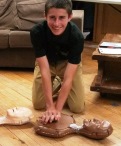Imagine a time when everywhere you go, you are surrounded by people ready to respond if your heart stops.
Lawmakers in 12 states are working toward that day. In hopes of producing future generations of lifesavers, those states have made CPR training -- including the use of an automatic external defibrillator (AED) -- a requirement for high school graduation. As this school year begins, seven states have laws in place or that go into effect this school year, with five more states having passed laws that will begin in upcoming years.
Vermont was one of the first states on board, thanks largely to the efforts of a boy who wasn't even in high school yet.
Tommy Watson was 12 when he saw a man watching a soccer match go into sudden cardiac arrest and collapse. More than 100 people were around, but only one -- a nurse -- knew CPR. That frustrated Tommy, so a few days later he called his local American Heart Association office and asked to be trained in Hands-Only CPR. Then he began training others. In less than two years, he's up to about 1,025 trainees.
I'm thrilled to turn this space over to Tommy to continue the discussion.
 No matter whether I'm training the governor of Vermont, a Japanese exchange student who hardly speaks English, or a room full of Girl Scouts, I always say the same thing: Learning CPR is easier than you think.
No matter whether I'm training the governor of Vermont, a Japanese exchange student who hardly speaks English, or a room full of Girl Scouts, I always say the same thing: Learning CPR is easier than you think.
It takes about two minutes. And there are only two steps.
If you see someone collapse:
- Call 9-1-1.
When I tell adults it only takes two minutes, some laugh and some are confused. They still think of CPR training as something that takes six hours and is so complicated they're probably going to forget it within a year. Then I explain about Hands-Only CPR and they are hooked.
The Hands-Only method is exactly what it sounds like.
You no longer need to give mouth-to-mouth breathing. Researchers figured out that adults have enough oxygen in their blood to circulate for about 10 minutes after a heart stops. So if someone pushes hard and fast, they can keep the patient's blood pumping until medical professionals get there. The key, of course, is having someone around who is ready to give those chest compressions.
It doesn't happen often enough. There's only about an 11 percent survival rate from sudden cardiac arrest. That means there's about an 89 percent chance of dying.
It is also why we need to train more lifesavers.
The first class I taught was a group of Boy Scouts. They all figured it out right away, and that made me feel good. I was like, "Wow, I enjoyed that!" I became really passionate about this, and the domino effect happened. I went from scouts to churches and schools, then to businesses and big trade events. I trained Vermont Gov. Peter Shumlin the day he signed the CPR in Schools law. My favorite training session was at the Heart Walk last fall, when I trained the exchange student from Japan. Being able to train a person who didn't speak English proved just how easy it is.
Since witnessing the cardiac arrest that inspired me, I have not been around anyone who has needed CPR. But I know of two teenagers who have. Both learned it at school and ended up saving the life of one of their parents.
Casey Stashenko's dad was resting after work in May 2012 when Casey's mom noticed that he was still wearing his suit jacket and tie, and that his face was gray. She called 9-1-1, then tried performing CPR but didn't know how. Casey told his mom she was doing it wrong and took over until the paramedics arrived. Doctors later discovered that Mr. Stashenko had a heart condition, and now he's doing well.
Last November, Lindsay Dolan's mom was watching a San Francisco 49ers game when her heart stopped. Lindsay came running when she heard her dad screaming. He called 9-1-1 and Lindsay began doing CPR until a neighbor who also knew CPR took over. Her mom got a defibrillator implanted and has made a full recovery.
Casey lives in upstate New York, and Lindsay lives near San Francisco. Their states are among the 38 that do not yet require CPR training in high school, which makes it even more amazing that they happened to get trained at school. It also shows why CPR training in schools is such a great idea. Hundreds of thousands of people could be trained that way each year. We'll end up with an entire generation of people who will go into the working world knowing how to save a life.
I really hope that happens. I also hope that one day someone I've trained ends up saving a life. That would be even more satisfying than doing it myself because it would show that what I'm teaching worked -- that someone remembered the skills and put them to use.
After all, there are only two steps. And it only takes two minutes to learn them.
Tommy Watson of Williston, Vermont, is a sophomore at Champlain Valley Union High School and the American Heart Association's 2013 Youth Advocate of the Year. When he's not teaching CPR, he enjoys playing basketball, skiing and other forms of physical activity.
The American Heart Association helped pioneer CPR more than 50 years ago, and continues to refine this lifesaving technique. The organization trains over 14.5 million people each year in 60-plus countries. To find a course, to learn about Hands-Only CPR or for other information, visit heart.org.

For more by Nancy Brown, click here.
For more on heart health, click here.